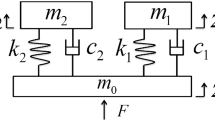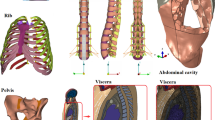Abstract
A generalized model of vibration isolation systems with a human body in a seated position is developed. The system dynamics is modeled for a single-axis transmission of vibration, that is, longitudinal x, lateral y and vertical z, to limit whole-body vibration exposure. The developed model can be successfully employed to describe the propagation of vibration waves from the source to a vibrating object. The proposed mathematical model can be widely used to protect a human body against vibration.
Similar content being viewed by others
References
A. Blazejewski, S. Glowinski and I. Maciejewski, The wavelet transfer function of a human body–seat system, Journal of Low Frequency Noise, Vibration and Active Control, Article first published online: January 10 (2018) Doi: 10.1177/1461348417747180.
M. J. Griffin, Handbook of human vibration, Elsevier Academic Press, London (1996).
I. Maciejewski and T. Krzyzynski, Method of selecting vibro–isolation properties of vibration reduction systems, Journal of Mechanical Science and Technology, 30 (4) (2016) 1497–1505.
British Standards Institution BS EN 13490, Mechanical vibration–Industrial trucks–Laboratory evaluation and specification of operator seat vibration, London (2002).
International Organization for Standardization, Agricultural wheeled tractors–Operator's seat–Laboratory measurement of transmitted vibration, ISO 5007, Geneva (2003).
International Organization for Standardization, Earthmoving machinery–Laboratory evaluation of operator seat vibration, ISO 7096, Geneva (2000).
M. Duke and G. Goss, Investigation of tractor driver seat performance with non–linear stiffness and on–off damper, Biosystems Engineering, 96 (4) (2007) 477–486.
C. C. Liang and C. F. Chiang, A study on biodynamic models of seated human subjects exposed to vertical vibration, International Journal of Industrial Ergonomics, 36 (2006) 869–890.
C. C. Liang and C. F. Chiang, Modeling of a seated human body exposed to vertical vibrations in various automotive postures, Industrial Health, 46 (2008) 125–137.
G. Joshi, A. K. Bajaj and P. Davies, Whole–body vibratory response study using a nonlinear multi–body model of seatoccupant system with viscoelastic flexible polyurethane foam, Industrial Health, 48 (2010) 663–674.
Directive 2002/44/EC of the European Parliament and of the Council, On the minimum health and safety requirements regarding the exposure of workers to the risks arising from physical agents (vibration), Official Journal of the European Communities (2002) 13–18.
S. Rutzel, B. Hinz and H. B. Wolfel, Modal description–A better way of characterizing human vibration behavior, Journal of Sound and Vibration, 298 (2006) 810–823.
G. J. Stein, P. Muka, R. Chmurny, B. Hinz and R. Bluthner, Measurement and modelling of x–direction apparent mass of the seated human body–cushioned seat system, Journal of Biomechanics, 40 (2007) 1493–1503.
M. Toward and J. Griffin, The transmission of vertical vibration through seats: Influence of the characteristics of the human body, Journal of Sound and Vibration, 330 (2011) 6526–6543.
International Organization for Standardization, Mechanical vibration and shock–Range of idealized values to characterize seated–body biodynmaic responce uder vertical vibraion, ISO 5982, Genewa (2001).
N. J. Mansfield, Human response to vibration, CRC Press, Boca Raton (2005).
S. Maeda and N. J. Mansfield, Comparison of the apparent mass during exposure to whole–body vertical vibration between Japanese subjects and ISO 5982 standard, Industrial Health, 43 (2005) 436–440.
G. J. Stein, P. Muka, B. Hinz and R. Bluthner, Measurement and modelling of the y–direction apparent mass of sitting human body–cushioned seat system, Journal of Sound and Vibration, 322 (2009) 454–474.
Author information
Authors and Affiliations
Corresponding author
Additional information
Recommended by Associate Editor Sungsoo Na
Igor Maciejewski is an Assistant Professor at the Koszalin University of Technology, Poland. He received his D.Sc. degree in the field of machine design and operation in 2013. His research interests focus on shaping the vibro-isolation properties of vibration reduction systems used for the protection of working machine operators.
Tomasz Krzyzynski is a Full Professor at the Koszalin University of Technology, Poland. He received his Ph.D. (1987) in Applied Mechanics and D.Sc. (1997) in Machine Design and Operation from the Institute of Fundamental Technological Research of the Polish Academy of Sciences. His research interests focus on the dynamics of mechatronic systems.
Rights and permissions
About this article
Cite this article
Maciejewski, I., Krzyzynski, T. Generalized model of vibro-isolation systems with seated human body for single-axis transmission of vibration. J Mech Sci Technol 32, 5163–5170 (2018). https://doi.org/10.1007/s12206-018-1014-y
Received:
Revised:
Accepted:
Published:
Issue Date:
DOI: https://doi.org/10.1007/s12206-018-1014-y




